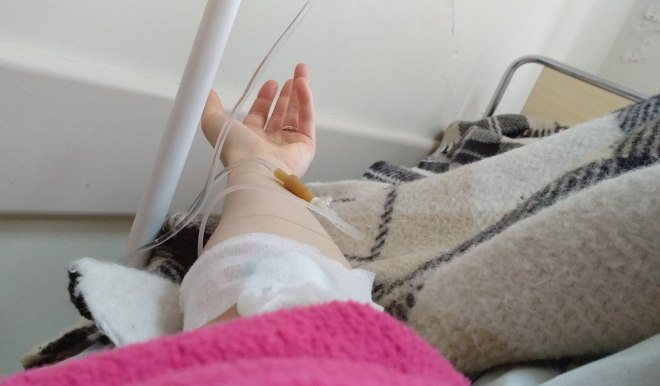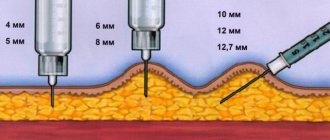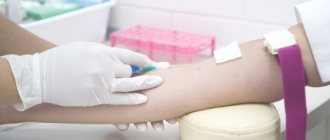Placement of an IV (price does not include medications)
1000 rub.
Sign up
Execution time: 1 working day
Placing a drip for intravenous infusion is a medical procedure for introducing vasoconstrictor and antibacterial compounds, plasma expanders, corticosteroids and many other medications into the patient’s circulatory system.
With the help of a dropper, doctors can introduce medicine directly into the patient's body, bypassing the digestive system. Entering the blood immediately, the solution begins to act immediately. The technique is very relevant for patients with exacerbation of bronchial asthma, stroke or heart attack, with various ailments, including severe dehydration.
The Raduga Clinic offers patients IV drips on an outpatient basis in St. Petersburg at affordable prices. The procedure is carried out by experienced clinic staff who will make the placement of an IV and intravenous administration of medications more comfortable.
Features of the introduction of a dropper
The design of the dropper is quite simple - it is a plastic device that includes a tube with a valve to regulate the intensity of the drug supply. Before starting the procedure, a special bottle is filled with the composition prescribed for the patient, one end of the dropper is inserted into it and fixed on an iron stand. The second end with a needle is inserted into the patient’s vein, determining the optimal rate of delivery of the medicine. This allows medications to enter the bloodstream as quickly as possible.
A clinic employee inserts an IV needle into the lumen of a venous vessel, usually the cubital vein is used for this. In clinically difficult situations, any other venous vessel that is most accessible can be used.
The advantages of an intravenous drip include the fact that the drug enters the body in small doses and gradually. This ensures its constant, uniform concentration in the blood, increasing the effectiveness of the procedure. At the same time, various side effects are reduced.
Attention!
Only a doctor can prescribe intravenous drips of medications!
Self-medication in this case is unacceptable. It is not recommended to install an IV yourself, since if the process is not followed, an infection may enter the patient’s body or air bubbles may enter the veins, which can lead to serious consequences.
Alcohol drip effect
The effect of the dropper is determined by what drugs the narcologist introduces into its composition. They are selected according to the existing symptoms, taking into account the patient’s health status, contraindications, etc. Infusion therapy has a complex effect:
- replenishing fluid deficiency in the bloodstream, thinning the blood to relieve stress on the heart;
- improvement of metabolism;
- normalization of water, acid-base, salt balance;
- rapid removal of toxins, breakdown products of ethyl alcohol;
- replenishment of vitamin and mineral deficiencies;
- increased blood glucose levels;
- relieving individual symptoms of intoxication (headache, nausea, vomiting, etc.).
Advantages of administering medications with a dropper:
- the bioavailability of the drugs used increases. They enter the blood faster, their concentration is higher, which accelerates the onset of the therapeutic effect;
- accelerated removal of alcohol from the body. The drip replenishes the fluid deficiency, but does not create excessive stress on the kidneys. Due to this, the excretory system begins to work more efficiently;
- the ability to use combinations of drugs. The dropper may contain several drugs, and their set and quantity can be quickly changed. This allows you to instantly adjust the treatment regimen by assessing the patient’s condition;
- when using droppers, no additional load is created on the digestive system, liver, kidneys, weakened by alcohol consumption.
Preparing for IV infusion
To place an IV in a medical center, no special preparation is needed. When prescribing an IV and a specific drug, the doctor collects the patient’s medical history, including determining the presence of an allergic reaction to individual components and finding out whether there is experience with intravenous administration of solutions. Based on the collected information, the doctor gives the patient a prescription, which indicates the dosage and rate of administration of the drug.
In some cases, the doctor may provide specific preparation recommendations and create a meal schedule. Some solutions cannot be administered using a dropper on an empty stomach, and vice versa; before some injections, it is not recommended to eat heavily or have snacks.
How to put an IV on yourself at home
First, you should prepare the place where the procedure will be performed. It must be clean. There must be a sofa or chair in the room on which you can sit during the IV. It is important to consider that this procedure takes a long time (from 40 minutes), so you need to provide yourself with comfortable conditions.
The next step is washing your hands with soap and treating them with a disinfectant solution (you can use alcohol). Then lay out everything you need on the table, after wiping it with a napkin with a disinfectant solution, and assemble the dropper.
Preparing the System and Related Accessories
You should learn how to assemble an IV. To do this, you need to prepare a tripod. If there is no such medical equipment in your home, then you will need a stand on which you can hang a bottle of medication. In extreme cases, you can use a flower stand. It is important that it be high enough, because during the manipulation the bottle will need to be secured at a height of at least 1.5 m from the floor.
Sterile gloves are put on washed and treated hands and the preparation of medicinal substances begins.
- Preparing a bottle with a solution. Remove the metal or plastic cover on it and wipe the rubber stopper with a cotton ball soaked in alcohol.
- Assembly of a disposable syringe. The sterile packaging in which it is located is torn. After this, connect the syringe tube to the needle.
- Using a sterile syringe, auxiliary medications are drawn from ampoules or vials and introduced into the bottle with the main solution through a rubber cap.
Algorithm for preparing the system for infusion:
- Open the sterile packaging and remove the system from it.
- Lower the regulator wheel to compress the tube and block the dropper.
- Insert the end of the dropper with the needle into the rubber cap of the bottle with the medicine. Insert the second needle (“air”), which is in the bag with the dropper, into it.
- The wide reservoir on the system must be squeezed 3 times so that it is half filled with liquid from the bottle.
- Place the free end of the dropper either in a sterile tray or in the same package.
- Raise the regulator wheel up until the liquid completely fills the infusion system. As soon as it starts to pour out from the free end, lower the wheel.
- Carefully inspect the tube - there should not be a single air bubble in it. If it is, then the wheel needs to be lifted again and a little more liquid drained so that the air comes out of it.
- Insert the free end of the dropper into a needle inserted into the bottle.
It is necessary to strictly adhere to the instructions and observe all safety measures so as not to harm yourself or another person.
Subtleties of administration and safety
A dropper is an effective treatment for many diseases. Modern algorithms for the treatment of certain pathologies often include this manipulation, since the effect of its use appears quickly. But if the patient himself puts an IV at home, then he needs to adhere to some safety measures so as not to harm himself:
- Perform all manipulations only with sterile gloves;
- You need to lie down during the procedure;
- if a person has a history of thrombophlebitis, then the procedure should be abandoned;
- inserting a needle into a vein near areas with ulcers is strictly prohibited;
- You cannot sleep during the infusion - you need to constantly monitor the supply of the solution;
- After administering the medicine, you need to lie down for about half an hour; you should not get up suddenly.
When to drip
The prepared bottle with the system is placed on a tripod (1.5 m from the floor). All necessary tools and materials are located nearby. The person should sit or lie down comfortably.
Instructions for placing an IV:
- Apply a tourniquet 10 cm above the elbow bend and bend the hand into a fist. The most filled and protruding vein is determined.
- The skin at the site of future injection is treated with alcohol.
- A venous vessel is fixed on the arm and pressed down with a finger (below the site of future injection).
- Take the needle, which is located at the second end of the infusion system, in your hands, turn it with the cut up and remove the cap. The skin is pierced and the needle is inserted parallel to the vein and then at an angle of 45 degrees. As soon as the wall of the vessel is punctured, you will feel a “fall into emptiness” and dark blood will appear in the cannula of the needle. This suggests that it is located in a venous vessel and can be fixed with an adhesive plaster.
- You can remove the tourniquet and unclench your fist.
- Raise the regulator wheel and adjust the delivery rate of the medicinal substance.
- At the end of the procedure, the wheel is lowered again, the needle is removed from the vein, and the puncture site is covered with cotton wool and alcohol.
How long do you put an IV?
The average duration of the procedure is from 40 minutes to 3 hours. It all depends on which drug needs to be instilled, since each drug has its own rate of administration. In addition, you need to pay attention to the patient’s condition. For example, if you are severely dehydrated, you should not immediately drip solutions too quickly, as this can harm the heart and blood vessels.

Indications for placing an IV in the clinic
The doctor prescribes an IV for severe vomiting or diarrhea, burns and large loss of fluid. Intravenous infusion is useful in cases of acid-base or water-salt imbalance, in which the kidneys and heart suffer the most.
In addition, intravenous infusion is given in the following cases:
- Restoration of blood supply
- Brain swelling
- Problems in the functioning of internal organs
- Intoxication of the body
- Local or generalized infection
- Preserving Metabolism
- The need to normalize sugar or cholesterol levels in diabetes
- Relieving pain and swelling
The procedure is indispensable for the administration of solutions and blood components that should not be injected into the muscles.
What are decongestant drips?
These are droppers containing decongestant components. These drip infusions use diuretics. These drugs are aimed at removing excess fluid from the body. They are actively used during rehabilitation after surgery and during the course of chemotherapy in the treatment of oncology. In the treatment room of the MRI center and clinic RIORIT, you have the opportunity to undergo treatment using drip administration of drugs under the supervision of experienced doctors and in comfortable conditions. If you need help choosing the right medications for your IVs, our clinic's therapist with 25 years of experience will be happy to advise you on this issue. Call! Your Health is Your RIORIT!
Who needs IVs
You may be prescribed IVs for the treatment of a variety of diseases. For example, doctors often recommend taking a course for the following diagnoses and conditions:
- Lack of fluid. Dehydration is a serious condition that can be treated with IV drips. Intravenous infusions normalize the patient’s condition and relieve the lack of fluid and electrolytes. Such solutions include universal necessary components that improve the functioning of organs and systems.
- Poisoning. Intoxication of the body can be a consequence of drinking alcoholic beverages, spoiled foods, or simply inappropriate food and water. In this case, we advise you to choose infusion administration, because a dropper at home - its price is much more favorable than many drugs - ensures rapid distribution of the drug and the desired therapeutic effect.
In addition, droppers are in no way inferior to tablets, capsules, gels and other dosage forms in terms of their effectiveness. For example, only intravenous infusions can help administer large doses of medications when the patient requires a long and constant supply of the drug. They are especially effective for patients who are unable to swallow tablets or capsules on their own.
Some medications do not even have analogues, so in order to undergo treatment, you will need to see a specialist and take a course of IV drips at home.








